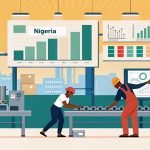Manufacturing Cost Analysis in Nigeria is crucial for enhancing operational efficiency and maintaining financial resilience within a competitive environment. By examining key elements such as direct materials, labor, and overhead costs, we can pinpoint areas for enhancement and increase profitability. The varied wage structures and material expenses in Nigeria necessitate meticulous management to control costs effectively. Furthermore, regulatory aspects and supply chain dynamics significantly influence overall cost management. Through a detailed exploration of specific strategies and trends in our Manufacturing Cost Analysis in Nigeria, we can reveal insights that facilitate improved decision-making and operational advancements, setting the stage for sustainable growth in the future.
Key Takeaways
1. Manufacturing Cost Analysis in Nigeria: Optimizing Direct Materials and Labor Costs for Efficiency
Analyzing direct materials and labor costs is essential for optimizing manufacturing efficiency in Nigeria's diverse economic landscape.
2. Understanding Overhead Costs in Nigeria: A Key Component of Manufacturing Cost Analysis
Understanding overhead costs, including utilities and maintenance, is crucial for financial resilience in fluctuating market conditions.
3. Implementing Activity-Based Costing (ABC) in Nigeria: A Strategic Approach to Manufacturing Cost Analysis
Implementing activity-based costing (ABC) allows for accurate allocation of costs to specific activities, promoting informed decision-making.
4. Lean Manufacturing Principles: Enhancing Profitability Through Manufacturing Cost Analysis in Nigeria
Lean manufacturing principles can significantly reduce waste and improve operational efficiency, enhancing overall profitability.
5. Manufacturing Cost Analysis in Nigeria: Benchmarking Against Competitors for Improved Cost Management
Benchmarking against competitors provides insights into market positioning and helps identify areas for improvement in cost management.
Importance of Cost Analysis
The Essential Role of Cost Analysis in Manufacturing Operations
Cost analysis is essential in manufacturing as it serves as the cornerstone of effective operational management. By conducting a detailed examination of our costs, we can pinpoint areas where we can enhance cost efficiency. A thorough understanding of the expenses linked to each production phase empowers us to allocate resources more effectively, reduce waste, and ultimately improve our bottom line.
In addition, cost analysis is critical for financial forecasting. By analyzing historical cost data, we can make informed predictions about future expenses and revenues. This foresight allows us to establish realistic budgets, align our production schedules with market demand, and make strategic decisions that enhance our competitiveness.
Our experience shows that regular cost analysis fosters a culture of accountability within our teams. When team members comprehend how their roles influence overall costs, they are more inclined to take ownership of their responsibilities and strive for improvements.
Furthermore, cost analysis enables us to identify trends and variances, facilitating proactive responses instead of reactive measures. This agility in adapting to market changes significantly bolsters our resilience in a dynamic business environment.
Key Components of Manufacturing Costs
Understanding the significance of cost analysis naturally leads us to examine the key components of manufacturing costs. At the heart of these costs are direct materials, direct labor, and overhead, each playing a fundamental role in the overall expense structure.
Firstly, raw material sourcing is foundational. The type and quality of raw materials we choose directly impact our production costs and, consequently, our profit margins. By optimizing our sourcing strategies, we can reduce costs while maintaining quality, which boosts our competitive edge in the market.
Next, direct labor represents the workforce involved in the manufacturing process. While we won't explore labor costs in detail here, it's crucial to recognize how skilled labor contributes to production efficiency. Efficient labor practices minimize waste and improve output, which is essential for maintaining cost-effectiveness.
Overhead costs, which include utilities, maintenance, and administrative expenses, also factor into our manufacturing costs. Streamlining these overheads through better resource management can lead to significant savings.
Moreover, the synergy between raw material sourcing and production efficiency cannot be overstated. When we procure high-quality materials at competitive prices and combine that with efficient production methods, we set the stage for a robust manufacturing operation.
Labor Costs in Nigeria
As we delve into the intricacies of labor costs in Nigeria, it is vital to acknowledge the distinctive economic landscape that influences these expenses. The labor market in Nigeria exhibits varied wage structures shaped by regional economic conditions and industry demands. Gaining insight into these nuances is crucial for understanding the broader manufacturing cost framework.
Current employment trends indicate an increasing demand for skilled labor, which carries significant implications for wage negotiations and productivity. Companies are actively seeking workers with specialized skills, prompting a transformation in training programs designed to enhance skill development. This movement not only aids in bridging the skills gap but also raises the average wage levels within specific sectors.
Additionally, labor laws in Nigeria significantly impact labor costs. These regulations dictate minimum wage standards, overtime compensation, and other employment benefits that manufacturers are required to comply with. The influence of labor unions can further sway wage negotiations, consequently affecting the overall labor costs for businesses. Unions often advocate for improved pay and working conditions, which may elevate expenses but also enhance employee satisfaction and retention.
Material Expenses Breakdown
The Critical Role of Material Expenses in Manufacturing Cost Analysis
Material expenses are a vital aspect of our manufacturing cost analysis, significantly influencing overall profitability. Understanding how we manage these costs is essential for optimizing our operations. In Nigeria, material sourcing plays a pivotal role in determining our bottom line. We must evaluate our supplier partnerships, ensuring they deliver quality materials at competitive prices. By analyzing our purchasing strategies, we can uncover opportunities for bulk purchasing or alternative sourcing options, ultimately reducing our material expenses.
Balancing Cost and Quality in Material Sourcing
Furthermore, we must recognize the connection between material sourcing and production efficiency. Relying on subpar materials can result in production delays and increased waste, which ultimately drives costs higher. Therefore, it is crucial to strike a balance between cost and quality in our material choices. Investing in reliable suppliers can enhance our production efficiency, leading to improved output and minimized operational disruptions.
Optimizing Inventory Management to Control Material Expenses
In addition, we should consistently review our inventory management practices. Efficient inventory control minimizes unnecessary material costs and helps us prevent stockouts that could halt production. By implementing just-in-time (JIT) inventory systems, we can lower holding costs while ensuring a steady supply of materials when needed.
Overhead Costs Overview
Understanding Overhead Costs: A Key to Manufacturing Success
While managing material expenses is fundamental to our manufacturing success, we must also focus on overhead costs, which greatly impact our overall financial health. Overhead costs encompass all the indirect expenses associated with production, including utilities, rent, salaries of support staff, and equipment maintenance. Understanding these costs is crucial, as they often represent a significant portion of our total expenditure.
The Importance of Effective Overhead Cost Allocation
Effective overhead allocation is essential in ensuring that we accurately distribute these costs across our products. By doing so, we can gain a clearer picture of each product's profitability, allowing us to make informed decisions regarding pricing and resource allocation. Regular analysis of our overhead costs is necessary to identify areas where we can improve efficiency and reduce waste.
Strategies for Managing Overhead Costs
Cost management strategies play a significant role in controlling overhead expenses. For instance, implementing standardized processes can streamline operations and help us avoid unnecessary costs. Additionally, investing in technology can automate certain tasks, reducing reliance on manual labor and, consequently, decreasing labor-related overhead.
Navigating Overhead Costs in a Fluctuating Economy
In Nigeria, where manufacturing can be influenced by fluctuating economic conditions, understanding our overhead costs is more imperative than ever. By prioritizing overhead cost analysis, we can enhance our financial resilience and adapt to market changes. Ultimately, a thorough approach to managing overhead costs not only aids in maintaining profitability but also strengthens our competitive position in the manufacturing landscape.
Fixed vs. Variable Costs
We often encounter the critical distinction between fixed and variable costs when analyzing our manufacturing expenses, and understanding this difference is fundamental for effective financial management. Fixed costs are those that remain constant regardless of the level of production. These include rent, salaries of permanent staff, and equipment depreciation. Conversely, variable costs fluctuate with production volume. Raw materials, direct labor, and utilities are prime examples of variable costs, as they increase or decrease based on our output.
Recognizing these differences between fixed and variable costs helps us develop appropriate cost structures, allowing us to manage our budgets more effectively. For instance, during periods of low production, high fixed costs can strain our financial resources, while variable costs offer the flexibility to adjust in line with our output levels. This understanding is critical for financial forecasting, enabling us to anticipate our expenses accurately and make informed decisions about scaling operations or optimizing resource allocation.
Moreover, by analyzing our fixed and variable costs, we can identify potential areas for cost reduction. For instance, if we can convert fixed costs into variable ones—such as outsourcing certain functions—we may gain greater flexibility in our operations. Ultimately, a clear grasp of fixed and variable costs not only aids in maintaining profitability but also enhances our overall strategic planning in the manufacturing sector. As we navigate the complexities of manufacturing cost analysis in Nigeria, this knowledge will serve as an essential tool in our financial toolkit.
Cost Analysis Methods
Understanding fixed and variable costs lays the foundation for utilizing various cost analysis methods that can enhance our manufacturing efficiency. By conducting a thorough analysis of these costs, we can implement effective cost estimation techniques that ensure we not only cover our expenses but also optimize our resources. One prominent method we can adopt is activity-based costing (ABC), which enables us to assign costs to specific activities, offering a clearer view of where our expenses are incurred.
Another valuable method to consider is standard costing, where we establish predetermined costs for our manufacturing processes. This approach allows us to compare actual costs against our standards, helping us identify variances and make necessary adjustments. Furthermore, we should examine contribution margin analysis, which evaluates how much revenue contributes to covering fixed costs, ultimately assisting us in shaping our pricing strategies.
The implementation of these cost analysis methods transcends mere data collection; it's about making informed decisions that enhance our profitability. For example, a deep understanding of our cost structure empowers us to develop competitive pricing strategies, ensuring we remain viable in the market while satisfying customer expectations.
Identifying Cost Drivers
Identifying Cost Drivers: A Path to Enhanced Manufacturing Efficiency
Identifying cost drivers is vital for accurately evaluating and managing our manufacturing expenses. By pinpointing the factors that influence our costs, we can implement effective cost allocation strategies that improve our financial decision-making. In our analysis, we need to focus on understanding how various activities contribute to our overall cost structure. This is where activity-based costing (ABC) comes into play.
Through ABC, we can allocate costs more precisely by assigning them to specific activities rather than broadly categorizing them. This method allows us to see which processes are the most resource-intensive and where we can potentially reduce waste. For instance, we might discover that certain production lines consume more materials and labor than anticipated, indicating a need for operational adjustments.
It's also important to evaluate both direct and indirect cost drivers. Direct costs, like raw materials and labor, are easily identifiable. However, indirect costs often require a deeper examination of our operational processes. By analyzing how overhead expenses are incurred in relation to different manufacturing activities, we can better understand the full financial impact of our operations.
In our pursuit of identifying cost drivers, we should remain vigilant and continuously review our findings. By adopting a proactive approach to cost analysis, we can make informed decisions that lead to increased efficiency and profitability. In the end, understanding our cost drivers will enable us to optimize our manufacturing processes and improve our competitive edge in the market.
Benchmarking Against Competitors
Benchmarking Against Competitors: A Strategic Approach to Cost Analysis
Having established a clear picture of our cost drivers, the next logical step involves engaging in benchmarking against competitors. This cost comparison is essential for understanding where we stand in the market. By conducting a thorough competitive analysis, we can identify effective pricing strategies that align with our market positioning.
In our benchmarking efforts against rivals, we should focus on key efficiency metrics and productivity standards. These indicators reveal how well we're utilizing our resources compared to industry norms. For instance, if our productivity ratios lag behind competitors, it signals a need for improvement in operational efficiency.
Furthermore, examining financial ratios during our benchmarking process is significant. Profit margins, return on assets, and inventory turnover rates provide insights into how effectively we manage costs relative to our competitors. Understanding these financial ratios helps us pinpoint areas where we may be overspending or underperforming.
Additionally, it's essential to keep an eye on competitors' pricing strategies as part of our benchmarking analysis. Are they offering similar products at lower prices, or do they justify higher prices through superior quality? This knowledge allows us to adjust our pricing strategies to remain competitive without sacrificing margin.
Ultimately, benchmarking isn't just about identifying gaps; it's about leveraging insights to improve our operational framework. By integrating competitive analysis into our manufacturing cost analysis in Nigeria, we position ourselves for sustained growth and enhanced profitability. As we move forward, let's ensure our strategies are informed by these critical comparisons through effective benchmarking.
Strategies for Cost Reduction
Cost Reduction Strategies: Enhancing Profitability and Competitiveness
Successful companies understand the importance of cost reduction strategies as a means to enhance profitability and stay competitive in the market. By adopting lean manufacturing principles, we can significantly improve operational efficiency and eliminate waste in our processes. This involves conducting a thorough analysis of our value stream to pinpoint bottlenecks and identify areas ripe for improvement.
A comprehensive cost optimization plan is essential for effective resource allocation. Regular financial forecasting allows us to anticipate future costs and adjust our strategies accordingly. This proactive approach ensures our agility in a fast-paced market landscape.
Strategic sourcing is a critical component of our cost reduction strategies. By negotiating better terms with suppliers and exploring alternative materials, we can substantially reduce production costs while maintaining quality standards. Additionally, fostering a culture of continuous process improvement is vital; we must encourage our teams to identify inefficiencies and propose enhancements.
Moreover, waste reduction extends beyond materials; it encompasses time and labor as well. By streamlining workflows and automating repetitive tasks, we can achieve significant savings, further reinforcing our commitment to effective cost reduction strategies.
Impact of Technology on Costs
The Transformative Impact of Technology on Manufacturing Costs in Nigeria
In today's manufacturing landscape, we cannot overlook how technology profoundly impacts costs. The integration of advanced technologies has revolutionized our approach to manufacturing cost analysis, particularly in Nigeria. The benefits of automation are at the forefront of this transformation, enabling us to streamline operations, reduce labor costs, and minimize human error. By implementing automated systems, we can enhance production efficiency and significantly lower operational expenses.
Digital transformation plays a critical role in this shift. By adopting cutting-edge software for inventory management, production scheduling, and quality control, we gain valuable insights that empower us to optimize processes. This data-driven approach allows us to identify inefficiencies and make informed decisions, ultimately leading to cost reductions. For example, predictive maintenance technologies can foresee machinery failures, enabling us to address issues before they culminate in costly downtime.
Furthermore, the deployment of IoT (Internet of Things) devices facilitates real-time monitoring of manufacturing processes, enhancing our capability to manage costs effectively. By analyzing data collected from these devices, we can fine-tune operations and minimize waste, thus driving down overall expenses.
Supply Chain Considerations
Optimizing Supply Chain Considerations in Manufacturing
The advancements in technology not only reshape our manufacturing processes but also considerably influence supply chain considerations. As we navigate the complexities of manufacturing cost analysis in Nigeria, it is essential to focus on optimizing supply chain operations. Effective logistics management is critical for ensuring that resources flow seamlessly from suppliers to production facilities, minimizing delays and reducing costs.
The Role of Inventory Control in Supply Chain Considerations
Inventory control plays a significant role in maintaining lean and responsive operations. By implementing advanced demand forecasting techniques, we can predict customer needs more accurately, allowing us to adjust our inventory levels accordingly. This proactive approach not only reduces excess stock but also enhances our ability to meet market demands swiftly.
Building Strong Supplier Relationships for Enhanced Supply Chain Considerations
Developing strong supplier relationships is a key aspect of effective supply chain management. By collaborating closely with our suppliers, we can negotiate better terms and ensure the timely delivery of materials. This partnership fosters transparency, enabling us to respond quickly to any disruptions in the supply chain.
Strategic Procurement for Competitive Advantage in Supply Chain Considerations
Moreover, robust procurement strategies are essential for maintaining a competitive advantage. By broadening our supplier base and incorporating risk management practices, we can mitigate potential disruptions that could impact our manufacturing processes.
Regulatory Factors in Nigeria
Navigating the Regulatory Landscape in Nigeria: Challenges and Opportunities for Manufacturers
Steering through the regulatory landscape in Nigeria presents both challenges and opportunities for manufacturers. Understanding regulatory compliance is fundamental, as it directly impacts operational costs and market access. We face a complex web of environmental regulations and industry standards that demand our attention. These regulations not only dictate production processes but also require investment in sustainable practices, which can initially seem burdensome.
However, there are government incentives designed to promote manufacturing growth. By leveraging these incentives, we can offset some compliance costs and improve our competitive edge. It's essential to stay informed about these opportunities, as they can greatly influence our financial strategies.
The Impact of Trade Policies on Manufacturing in Nigeria
Trade policies also play a significant role in shaping our manufacturing landscape. They dictate import tariffs and export restrictions, which can impact our supply chain and pricing strategies. Understanding these policies allows us to maneuver potential hurdles effectively while capitalizing on favorable conditions.
Understanding Tax Implications for Manufacturers in Nigeria
Tax implications are another critical aspect we must consider. The tax environment in Nigeria can be complex, with various incentives available for manufacturers. By strategically planning our operations, we can minimize tax liabilities and improve profitability.
Ensuring Safety Regulations in Nigerian Manufacturing
Lastly, adhering to safety regulations is non-negotiable. Ensuring a safe working environment not only protects our workforce but also boosts our brand reputation. By prioritizing compliance with safety standards, we can lessen risks and foster a culture of responsibility.
Case Studies of Successful Analysis
Maneuvering the complexities of regulatory compliance and trade policies in Nigeria has prompted many manufacturers to adopt effective cost analysis strategies. One compelling case study we encountered involved a mid-sized textile company. Faced with rising raw material costs and increasing competition, they implemented a thorough manufacturing cost analysis. By evaluating their production processes, they identified inefficiencies that were driving up costs. Through targeted process optimization, they streamlined their supply chain, significantly enhancing cost efficiency.
Another notable example is a beverage manufacturer that utilized cost analysis to re-evaluate its packaging processes. By analyzing labor and material expenses, they discovered that switching to a different supplier could reduce costs without compromising quality. This shift not only improved their profit margins but also allowed them to reinvest savings into marketing and product development.
In both cases, the manufacturers leveraged data-driven insights to make informed decisions that led to substantial improvements in operational efficiency. They demonstrated that regular cost analysis isn't just a reactive measure but a proactive strategy that can position businesses for growth in a challenging economic environment.
These examples highlight the power of manufacturing cost analysis in Nigeria. By focusing on cost efficiency and process optimization, companies can overcome obstacles and seize opportunities for advancement. As we explore deeper into the landscape of manufacturing, these success stories serve as proof of the transformative potential of strategic cost management.
Future Trends in Manufacturing Costs
As we explore Future Trends in Manufacturing Costs, it's evident that several emerging factors will significantly influence this landscape. A paramount trend is the increasing emphasis on sustainability initiatives. Companies are not only aiming to minimize their environmental impact but are also recognizing that sustainability can yield cost savings over time. By embracing cleaner technologies and more efficient processes, manufacturers can reduce waste and energy consumption, ultimately lowering their operational costs.
In addition, global competition is steadily intensifying, urging manufacturers to innovate and enhance their cost structures. As international markets become more interconnected, businesses must adapt to sustain their competitive edge. This adaptation may involve investing in advanced automation technologies that streamline operations and reduce labor costs. With the rise of Industry 4.0, data analytics and artificial intelligence will become essential in identifying cost-saving opportunities and refining decision-making processes.
Furthermore, it's crucial to consider the influence of supply chain dynamics on manufacturing costs. Recent disruptions caused by geopolitical tensions or pandemics have underscored the necessity for more resilient supply chains. By diversifying suppliers and investing in local sourcing, manufacturers can mitigate risks and maintain better control over costs. These Future Trends in Manufacturing Costs will undoubtedly shape the strategies businesses employ to thrive in an evolving marketplace.
Frequently Asked Questions
How Can Small Manufacturers Benefit From Cost Analysis?
When exploring how small manufacturers can benefit from cost analysis, the advantages become evident. By conducting a thorough analysis of supply chain processes, we can uncover inefficiencies and streamline operations effectively. This not only leads to a significant reduction in waste but also allows for substantial savings in both money and resources. Through diligent cost analysis, we can accurately identify areas ripe for improvement, enhancing our financial decision-making capabilities. Ultimately, this approach empowers us to boost productivity, optimize our operational workflows, and drive sustainable growth within our businesses.
What Software Tools Aid in Manufacturing Cost Analysis?
When we consider software tools that aid in manufacturing cost analysis, several solutions stand out. These software solutions help streamline cost tracking, allowing businesses to monitor expenses in real-time. Tools like ERP systems and specialized cost management software empower manufacturers to analyze data effectively, optimizing production processes. By leveraging these technologies, companies can make informed decisions, boost efficiency, and ultimately improve profitability in the competitive manufacturing landscape.
How Often Should Cost Analysis Be Conducted?
When determining the optimal frequency for conducting cost analysis, we recommend implementing a regular schedule, ideally on a quarterly or biannual basis. This approach enables us to remain aligned with market trends and operational shifts. By utilizing diverse analysis techniques, we can pinpoint cost drivers and identify areas for improvement. Consistent assessments empower us to make informed decisions, enhance resource allocation, and increase overall efficiency, ensuring we maintain a competitive edge in the marketplace.
What Role Does Employee Training Play in Cost Reduction?
The Impact of Employee Training on Cost Reduction
Employee training plays a crucial role in cost reduction by enhancing employee involvement and promoting skills development. By investing in training, organizations empower their workforce to perform tasks more efficiently, which minimizes errors and waste. Well-trained employees are more likely to identify and implement cost-saving measures, resulting in increased productivity. Ultimately, fostering a culture of continuous learning not only reduces operational costs but also boosts morale and retention, creating a more resilient organization.
Can Cost Analysis Improve Product Pricing Strategies?
Absolutely, conducting a thorough cost analysis can significantly enhance our product pricing strategies. By concentrating on cost optimization, we can pinpoint inefficiencies and refine our pricing models accordingly. This approach allows us to align prices with production costs while maintaining competitiveness in the marketplace. Furthermore, a solid understanding of the correlation between costs and pricing empowers us to make data-driven decisions, ultimately boosting profitability without compromising on quality. In essence, a detailed cost analysis equips us to establish strategic pricing that accurately reflects the true value of our products.







